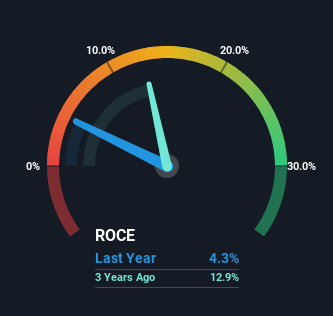Returns On Capital At Wiseway Group (ASX:WWG) Paint A Concerning Picture
If we want to find a potential multi-bagger, often there are underlying trends that can provide clues. Amongst other things, we'll want to see two things; firstly, a growing return on capital employed (ROCE) and secondly, an expansion in the company's amount of capital employed. Put simply, these types of businesses are compounding machines, meaning they are continually reinvesting their earnings at ever-higher rates of return. However, after briefly looking over the numbers, we don't think Wiseway Group (ASX:WWG) has the makings of a multi-bagger going forward, but let's have a look at why that may be.
What Is Return On Capital Employed (ROCE)?
For those who don't know, ROCE is a measure of a company's yearly pre-tax profit (its return), relative to the capital employed in the business. To calculate this metric for Wiseway Group, this is the formula:
Return on Capital Employed = Earnings Before Interest and Tax (EBIT) ÷ (Total Assets - Current Liabilities)
0.043 = AU$2.1m ÷ (AU$67m - AU$19m) (Based on the trailing twelve months to December 2023).
Therefore, Wiseway Group has an ROCE of 4.3%. In absolute terms, that's a low return and it also under-performs the Logistics industry average of 11%.
View our latest analysis for Wiseway Group

While the past is not representative of the future, it can be helpful to know how a company has performed historically, which is why we have this chart above. If you'd like to look at how Wiseway Group has performed in the past in other metrics, you can view this free graph of Wiseway Group's past earnings, revenue and cash flow.
What Does the ROCE Trend For Wiseway Group Tell Us?
On the surface, the trend of ROCE at Wiseway Group doesn't inspire confidence. To be more specific, ROCE has fallen from 6.8% over the last five years. Meanwhile, the business is utilizing more capital but this hasn't moved the needle much in terms of sales in the past 12 months, so this could reflect longer term investments. It's worth keeping an eye on the company's earnings from here on to see if these investments do end up contributing to the bottom line.
On a related note, Wiseway Group has decreased its current liabilities to 28% of total assets. So we could link some of this to the decrease in ROCE. What's more, this can reduce some aspects of risk to the business because now the company's suppliers or short-term creditors are funding less of its operations. Since the business is basically funding more of its operations with it's own money, you could argue this has made the business less efficient at generating ROCE.
The Bottom Line
Bringing it all together, while we're somewhat encouraged by Wiseway Group's reinvestment in its own business, we're aware that returns are shrinking. And in the last five years, the stock has given away 62% so the market doesn't look too hopeful on these trends strengthening any time soon. Therefore based on the analysis done in this article, we don't think Wiseway Group has the makings of a multi-bagger.
Since virtually every company faces some risks, it's worth knowing what they are, and we've spotted 3 warning signs for Wiseway Group (of which 1 can't be ignored!) that you should know about.
While Wiseway Group may not currently earn the highest returns, we've compiled a list of companies that currently earn more than 25% return on equity. Check out this free list here.
Valuation is complex, but we're here to simplify it.
Discover if Wiseway Group might be undervalued or overvalued with our detailed analysis, featuring fair value estimates, potential risks, dividends, insider trades, and its financial condition.
Access Free AnalysisHave feedback on this article? Concerned about the content? Get in touch with us directly. Alternatively, email editorial-team (at) simplywallst.com.
This article by Simply Wall St is general in nature. We provide commentary based on historical data and analyst forecasts only using an unbiased methodology and our articles are not intended to be financial advice. It does not constitute a recommendation to buy or sell any stock, and does not take account of your objectives, or your financial situation. We aim to bring you long-term focused analysis driven by fundamental data. Note that our analysis may not factor in the latest price-sensitive company announcements or qualitative material. Simply Wall St has no position in any stocks mentioned.
About ASX:WWG
Wiseway Group
Provides logistics and freight forwarding services in Australia, New Zealand, China, Singapore, and the United States.
Outstanding track record with excellent balance sheet.
Similar Companies
Market Insights
Community Narratives




